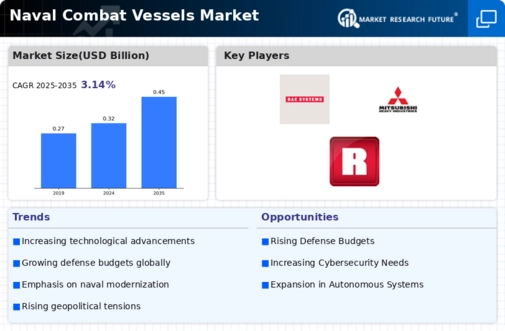Top Industry Leaders in the Naval Combat Vessels Market

Key Players:
BAE Systems (U.K)
Kawasaki Shipbuilding Corporation (Japan)
Lockheed Martin Corporation (U.S.)
Mitsubishi Heavy Industries Ltd. (Japan)
Raytheon (U.S.)
Strategies Adopted:
To maintain their competitive edge, key players in the naval combat vessels market are adopting multifaceted strategies. One prevalent approach is the integration of cutting-edge technologies, including artificial intelligence, advanced sensor systems, and stealth capabilities, to enhance the vessels' overall effectiveness and survivability. Concurrently, an emphasis on modular and scalable designs allows for easier upgrades and adaptability to evolving mission requirements. Additionally, collaborations and strategic partnerships with technology providers and research institutions are becoming increasingly common, facilitating knowledge exchange and accelerating innovation.
Factors for Market Share Analysis:
Several factors contribute to the market share dynamics in the naval combat vessels sector. Technological innovation and the ability to deliver high-performance vessels capable of addressing multifaceted threats are primary determinants. Long-standing relationships with defense ministries and governments, backed by successful track records in delivering reliable and cost-effective solutions, also play a pivotal role. Furthermore, the capacity to offer comprehensive through-life support services, including maintenance, repair, and training programs, strengthens a company's position in the market.
New and Emerging Companies:
While established players dominate the naval combat vessels market, there is a noticeable influx of new and emerging companies aiming to carve their niche. These companies often specialize in niche areas, such as unmanned maritime systems, cyber warfare solutions, or autonomous vessel technologies. Notable entrants include maritime tech startups like Ocean Infinity and Saildrone, leveraging advancements in autonomous systems to offer innovative solutions for surveillance, reconnaissance, and mine countermeasure operations.
Industry News:
The naval combat vessels market is dynamic, with frequent developments and announcements shaping its trajectory. Recent industry news indicates a growing focus on sustainability, with an increasing number of naval forces exploring hybrid propulsion systems and alternative fuels to reduce environmental impact. Additionally, the rise of unmanned surface vessels (USVs) is gaining traction, with navies incorporating these autonomous platforms for tasks such as mine countermeasures, intelligence, surveillance, and reconnaissance (ISR).
Current Company Investment Trends: Investment trends in the naval combat vessels market reflect the industry's evolving landscape. Companies are allocating significant resources to research and development, aiming to stay ahead in terms of technological innovation. Moreover, there is a notable trend of acquisitions and mergers, enabling companies to expand their product portfolios and enhance their market presence. Strategic investments in cybersecurity capabilities are also on the rise, as the digitalization of naval vessels exposes them to new and complex threats.
Overall Competitive Scenario:
The competitive scenario in the naval combat vessels market is marked by a delicate balance between traditional naval powerhouses and emerging players offering disruptive technologies. The landscape is evolving as countries reevaluate their defense priorities and seek solutions that align with modern threats. Adaptability, technological innovation, and strategic collaborations are becoming crucial elements for sustained competitiveness. As the market continues to grow, companies that can navigate geopolitical shifts, address emerging threats, and offer cost-effective solutions will position themselves as leaders in this dynamic and critical sector.
Recent News:
Lockheed Martin Corporation (LMT):
Secured a multi-billion dollar contract with the U.S. Navy to build the next generation of guided-missile destroyers, the DDG(X), showcasing cutting-edge stealth technology and enhanced firepower.
Successfully launched the third Zumwalt-class destroyer, featuring advanced weaponry and electric propulsion, marking a significant milestone in this innovative program.
BAE Systems plc (BAE):
Won a contract to upgrade the Type 45 destroyers of the Royal Navy, equipping them with new radar systems and weapons, ensuring their continued effectiveness in years to come.
Collaborating with the U.S. Navy on the development of the new Surface Ship Combat System, pushing the boundaries of command and control technology for naval operations.











